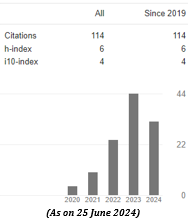Physical and Strength Properties of Cements Manufactured in Bangladesh: A Case Study
Abstract
This study investigates the physical qualities and strength properties of representative cements manufactured by different brands in Bangladesh. The physical and strength properties such as normal consistency, initial and final setting time, density, specific gravity, fineness, and compressive strength of cement mortars as well as concrete cylinders were investigated experimentally. Using CEM II/B-M type cement, a total of 300 test specimens are prepared to determine those parameters. In this case study, specimens were prepared from ten different representative cement industries of Bangladesh and tested as per ASTM specifications. The experimental result shows that the physical and strength parameters of nearly all the representative cement samples are within the ASTM recommended ranges that ultimately proofs the quality of Bangladeshi Cement. The relationship between mortar and concrete strengths from the same batch of cement has also been investigated. Besides, a regression analysis has been conducted to find relationships between the concrete strength and their age of curing. The influence of initial and final setting times on concrete strength is also investigated. This study also provides the relationships between compressive strengths, between mortar and concrete cylinders at different ages. These age dependencies of concrete strength will help to predict the actual concrete strength at the early age of curing which may ensure faster construction work.
Downloads
References
Ahmed, K. S., Habib, M. A. & Asef, M. F. (2021a). Flexural response of stainless steel reinforced concrete beam. Structures, 34, 589-603.
Ahmed, K. S., Shahjalal, M., Siddique, T. A. & Keng, A. K. (2021b). Bond strength of post-installed high strength deformed rebar in concrete. Case Studies in Construction Materials, e00581.
Ali, K. (2010). Chemical Analysis and Comparison of Ordinary Portland Cement of Khyber Pakhtoon Khwa Pakistan. Chemical Engineering Research Bulletin, 14, 45-49.
Amin, N. U. & Ali, K. (2009). Recycling of bagasse ash in cement manufacturing and its impact on clinker potential and environmental pollution. Journal of the Chemical Society of Pakistan, 31, 357-361.
ASTM‐C109 (2013). C109/C109M‐13 Standard Test Method for Compressive Strength of Hydraulic Cement Mortars (Using 2‐in. or [50‐mm] Cube Specimens).
ASTM (2001). ASTM C150: Standard specification for Portland cement. ASTM Philadelphia^ ePA PA.
ASTM (2012a). ASTM C595 / C595M-12, Standard Specification for Blended Hydraulic Cements, ASTM International, West Conshohocken, PA www.astm.org.
ASTM (2012b). Standard test method for compressive strength of cylindrical concrete specimens. ASTM, C39M-12.
ASTM (2016). ASTM C-187,Standard test method for normal consistency of hydraulic cement.: American Society of Testing Materials USA.
ASTM (2019). ASTM C191-19, Standard Test Methods for Time of Setting of Hydraulic Cement by Vicat Needle, ASTM International, West Conshohocken, PA, www.astm.org.
Barnett, S. J., Soutsos, M. N., Bungey, J. H. & Millard, S. G. (2007). Fast-track construction with slag cement concrete: adiabatic strength development and strength prediction. ACI materials journal, 104, 388.
EBL Securities Ltd. (2017). A Comprehensive Review on Bangladesh Cement Industry. Dhaka, Bangladesh.
Goldstein, H. (1995). Not your father's concrete. Journal of Civil Engineering, 65, 60.
Hani, F. F. B. (2011). Chemical analysis of ordinary portland cement of Jordan, Assiut Univ. Bull. Environ. Res, 14, 1-8.
Hasan, M. M. & Kabir, A. (2011). Prediction of compressive strength of concrete from early age test result. 4th Annual Paper Meet and 1st Civil Engineering Congress. 978-984.
Iffat, S. (2015). Relation between density and compressive strength of hardened concrete. Concrete Research Letters, 6, 182-189.
Islam, K., Billah, A. M., Chowdhury, M. M. I. & Ahmed, K. S. (2020). Exploratory study on bond behavior of plain and sand coated stainless steel rebars in concrete. Structures, 27, 2365-2378.
Mahmud, R. & Ahmed, K. S. (2020). Interface dependency of reinforced concrete jacketing for column strengthening. Proceedings of the Institution of Civil Engineers–Structures Buildings, 173, 31-41.
Mangi, S. A., Jamaluddin, N. B., Siddiqui, Z., Memon, S. A. & Ibrahim, M. H. B. W. (2019a). Utilization of sawdust in concrete masonry blocks: A review. Mehran University Research Journal of Engineering & Applied Technology, 38, 487–494.
Mangi, S. A., Wan Ibrahim, M. H., Jamaluddin, N., Arshad, M. F. & Putra JAYA, R. (2019b). Short-term effects of sulphate and chloride on the concrete containing coal bottom ash as supplementary cementitious material. Engineering Science and Technology, an International Journal, 22, 515-522.
Mohammed, T., Hasnat, A., Sarwar, N., DAS, H., Miah, J. & Awal, M. (2011). Sustainable Development of Construction Works in Bangladesh. EACEF-International Conference of Civil Engineering. 057-057.
Mohammed, T. U., Hasan, P., Islam, B., Hasnat, A. & Sharkia, S. (2012). Investigation on Different Cement Brands Commonly Used in Bangladesh. Third International Conference on Construction In Developing Countries (ICCIDC–III)“Advancing and Integrating Construction Education, Research & Practice”, Bangkok, Thailand.
Pourkhorshidi, A. R., Najimi, M., Parhizkar, T., Jafarpour, F. & Hillemeier, B. (2010). Applicability of the standard specifications of ASTM C618 for evaluation of natural pozzolans. Cement and Concrete Composites, 32, 794-800.
Rafi, M. & Nasir, M. (2014). Experimental Investigation of Chemical and Physical Properties of Cements Manufactured in Pakistan. Journal of Testing and Evaluation, 42, 774-786.
Soltani, A., Khoso, S., Keerio, M. A. & Formisano, A. (2019). Assessment of Physical and Mechanical Properties of Concrete Produced from Various Portland Cement Brands Open Journal of Composite Materials, Vol.09No.04, 11.
STANDARD, A. (2009). Annual Book of ASTM Standards. C188: Standard Test Method for Density of Hydraulic Cement.
TESTING, A. S. F. & MATERIALS. (2007) ASTM C 204: Standard Test Methods for Fineness of Hydraulic Cement by Air-Permeability Apparatus. 2007. ASTM Philadelphia.
Though MIJST follows the open access policy, the journal holds the copyright of each published items.

This work is licensed under a Creative Commons Attribution-NonCommercial 4.0 International License.
















